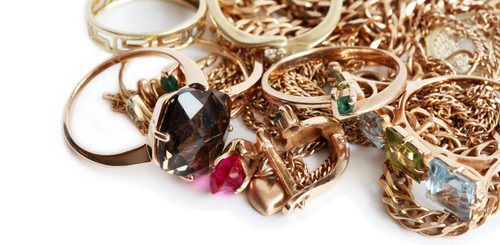Buying Estate Jewelry: Types Of Hallmarks To Know

Hallmarks make it easier to correctly determine the date of estate jewelry and who designed it. The most important hallmark to look for when buying estate jewelry is the purity mark which will reveal the amount of precious metal which was used in its manufacture. Hallmarks are a popular subject of study in the antiques business, and some professionals are so adept that they can determine the period and place where jewelry was manufactured without them. Below are some other important hallmarks.
Maker’s Marks
In the past, the maker’s mark denoted who was responsible for the amount of silver or gold which was present in a piece of jewelry. That way if a problem developed the maker could be identified. This doesn’t always mean that the object was created by the person whose mark is present; it just means that individual was responsible for its purity. In contemporary times the maker’s mark and trademark will usually be one and the same, with prominent names adding value.
In most countries a maker’s mark must be completely unique, and in the past were recorded and stored in guild archives. In some nations, such as France, manufacturers were expected to use a maker’s mark with a specific shape, which was lozenge for the French beginning in 1797. Maker’s marks didn’t catch on in the United States until the 1960s.
Town Marks
As the name suggests, this particular mark denotes the town or city where an item was manufactured. It started during medieval times and the renaissance when countries in Europe that had a compulsory hallmarking system established offices in various towns to work with regional metal smiths. The town mark was used to differentiate between the jewelry manufacturers within a specific city from other cities throughout the country. Traditionally the design for the town mark would be based on the heraldic shield that was already in use for that particular area. For example the city of Birmingham in the United Kingdom uses a town mark which features an anchor.
Purity Mark
The purity mark is the most popular hallmark. It is the first thing you should look for when evaluating jewelry, as it will tell you the amount of precious metal that was used in its creation. Gold in its highest purity is extremely soft and by itself is not very good for designing jewelry. Since ancient time’s metal workers have developed various methods for enhancing its strength usually by combining it with smaller quantities of other metals such as copper. This is called an alloy, or mixture of precious metals. The term “purity” simply denotes the quantity of precious metals which were used in the creation of the alloy.
Until the 20th century purity was determined by karats. This is a weight with 24 divisions, with 24 being the highest. However, the term Karat has fallen out of favor as many countries now use the metric system instead, where the purity is denoted in parts per thousand.


